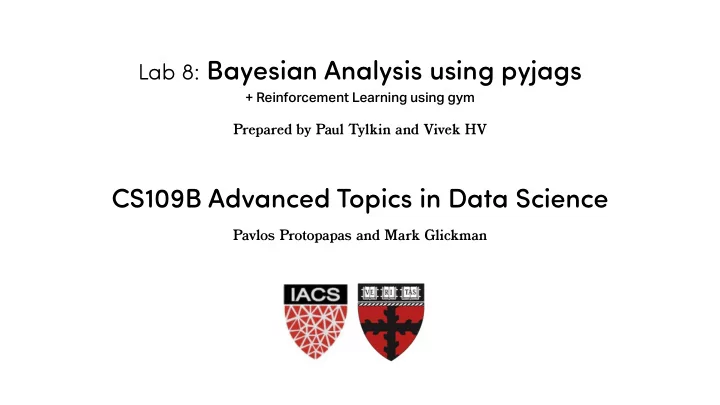

Lab 8: Bayesian Analysis using pyjags + Reinforcement Learning using gym Prepared by Paul Tylkin and Vivek HV CS109B Advanced Topics in Data Science Pavlos Protopapas and Mark Glickman
Myself! Vivek HV Masters in Design Engineering, SEAS & GSD Bachelors in Aerospace Engineering, IIT Madras Email: vivekhv@mde.harvard.edu Feel free to say hi or provide feedback! Conversation Starters: Cats, Waffmes, GANs, Art, CS, Math, Aerodynamics, Philosophy
Today’s agenda A brief overview of Bayesian Analysis Introduction to pyjags Reinforcement Learning using gym Coding and Q&A!
Bayesian Statistics You don’t (and should not) ignore your knowledge about the state of the world in summarizing conclusions based on data. Given your belief about the state of the world, you observe new data which could possibly update that state. Bayesian Statistics (and Analysis) lets you encode your prior in- formation which informs your fjnal results Founded on the subjective defjnition of probability - which is based on your degree of belief that an event will occur - can consider probabilities (and hence uncertainities) of values of unknown parameters
A brief overview of Bayesian Analysis 1. Formulate a model 2. Defjne prior distributions of unknown parameters 3. Construct likelihood function based on observed data 4. Determine the posterior distribution 5. Summarize from posterior distribution
An Example Lets assume we have data collected from a 100 coin fmips What is the probability that it is a fair coin /How fair is this coin?
An Example Model : All coin fmips return heads with a probability theta (and tails with 1-theta ) Prior : theta has a uniformly distributed probability between 0 and 1. Initialize with 0.5 Likelihood : Construct a likelihood based on observed data (HTHTHT -> theta * (1-theta) * ...) Posterior : Posterior is proportional to prior x likelihood or Posterior = c x prior x likelihood Summarize : Find mean value for theta
How to calculate the posterior distribution? In a few cases, there is a closed form solutions to the summaries of a posterior distribution. In most cases (real world models), high dimensionality and complex likelihood functions mean that it is not possible to analytically summarize your posterior distribution. Thats where Monte Carlo simulations come in. Take a very large sample from the posterior distribution and use sample summaries as approximate actual summaries.
How to calculate the posterior distribution? What about Markov Chain Monte Carlo? Sometimes, the posterior densities are too complex/non-standard that even Monte Carlo simulations become hard. Markov chain has a stationary distri- bution which is the same as the target distribution. Running a markov chain long enough will converge it to the target distribition - in this case the poste- rior distribution How to run a MCMC? Lot of options. We will be using Gibbs Sampler to run multiple markov chains Run the markov chains for a burn-in period where the difgerent chains start to converge Sample after burn-in period and summarize from sample
Introduction to pyjags pyjags in a python interface to JAGS (Just Another Gibbs Sam- pler). Gibbs is just one of many difgerent MCMC samplers You should have it already installed on Jupyter Hub! If you have been to Lab 1 (or used the confjg to create your con- da environment, you should have pyjags installed) pyjags does not support Windows :(
Introduction to pyjags If you are installing it today on your local computer: Download and install JAGS (Use its default installation location to avoid changing confjguration) pip install pyjags If you have a mac you might run into a gcc error, export an env variable required by the installation using: export MACOSX_DEPLOYMENT_TARGET=10.9
Let’s try doing some Bayesian Analysis!
Reinforcement Learning using gym If you have not done so already pip install gym
That’s all folks!
Recommend
More recommend